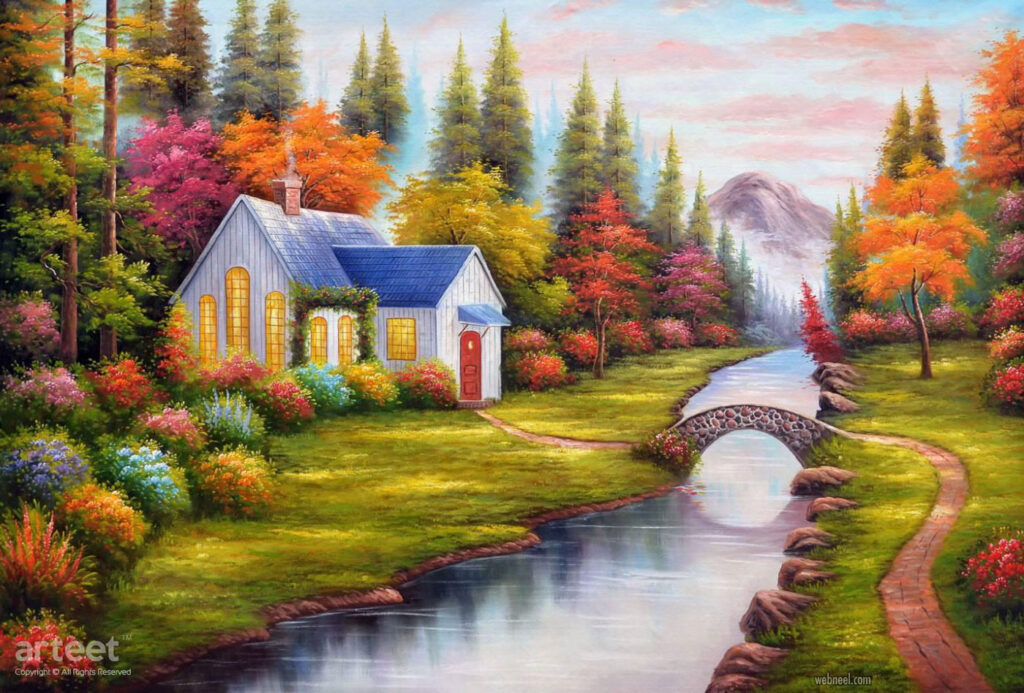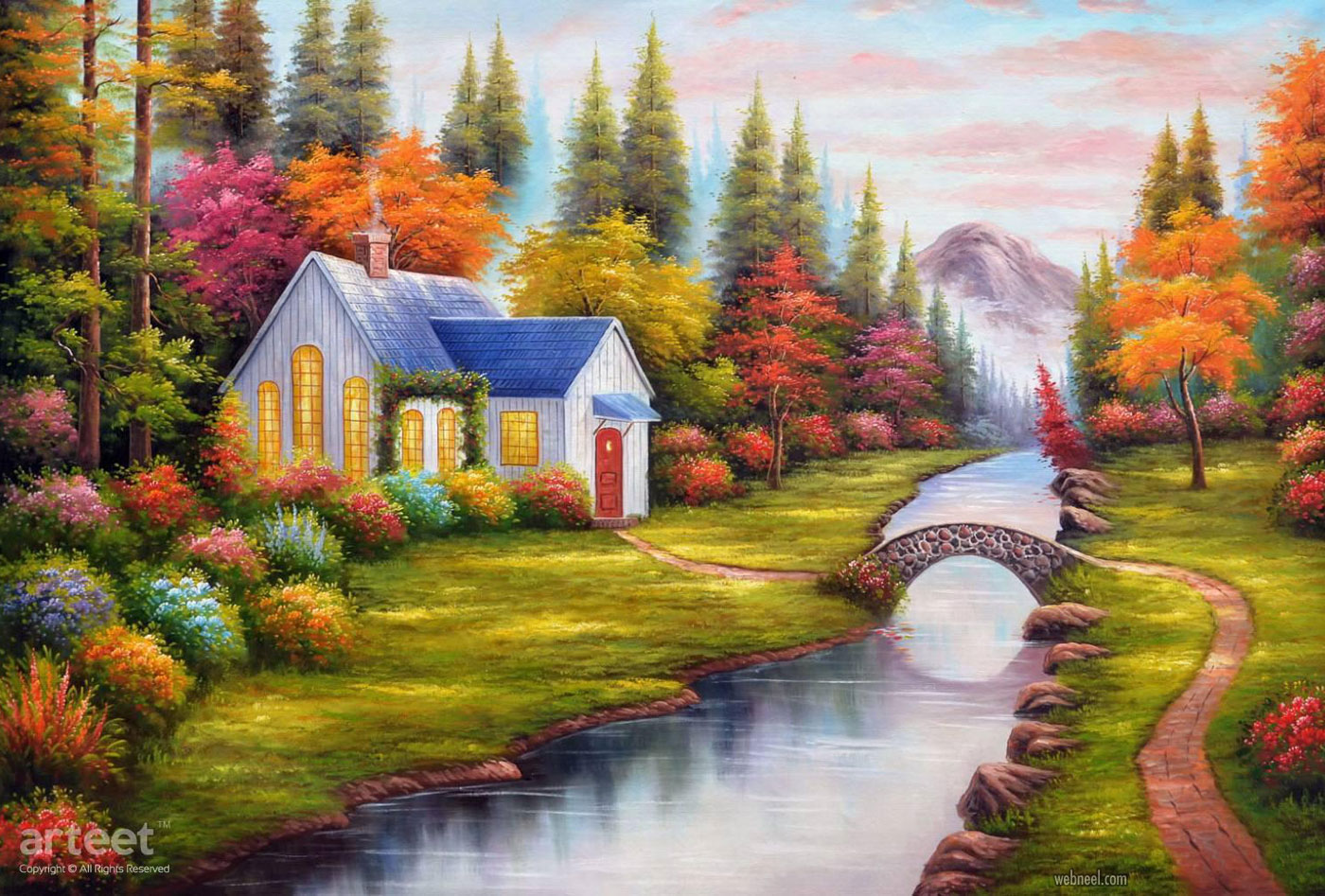
Capturing the Essence: Exploring Artistic Landscapes Through Photography and Painting
The allure of artistic landscapes has captivated artists and audiences alike for centuries. From the sweeping vistas of the Hudson River School to the intimate details captured by modern photographers, the land around us provides endless inspiration. This article delves into the world of artistic landscapes, exploring how different mediums, particularly photography and painting, are used to interpret and represent the beauty and power of nature. We will examine the techniques, historical context, and contemporary trends that shape our understanding of this enduring genre.
The Historical Roots of Artistic Landscapes
The depiction of landscapes in art has evolved significantly over time. Early landscape paintings often served as backdrops for religious or mythological scenes, with nature playing a secondary role. However, during the Renaissance, artists began to appreciate the inherent beauty of the natural world, leading to a greater focus on accurate representation and atmospheric perspective. The Dutch Golden Age saw the rise of landscape painting as a distinct genre, with artists like Jacob van Ruisdael and Jan van Goyen capturing the unique character of the Dutch countryside.
The 19th century witnessed a surge in landscape painting, driven by Romanticism’s emphasis on emotion and the sublime. Artists like J.M.W. Turner and Caspar David Friedrich sought to convey the awe-inspiring power and spiritual significance of nature through their dramatic compositions and expressive brushwork. In America, the Hudson River School emerged, celebrating the vastness and beauty of the American wilderness. Artists such as Thomas Cole and Frederic Church created monumental canvases that captured the grandeur of the Hudson River Valley and other iconic landscapes.
Photography as a Medium for Artistic Landscapes
The invention of photography in the 19th century revolutionized the way landscapes were depicted. Early landscape photographers, such as Carleton Watkins and Ansel Adams, used large-format cameras and meticulous printing techniques to create stunning images of the American West. Their photographs not only documented the landscape but also conveyed a sense of its scale, texture, and atmosphere. Adams, in particular, is renowned for his black-and-white photographs of Yosemite National Park, which are considered masterpieces of landscape photography. His work emphasized pre-visualization and careful control of the photographic process to achieve the desired artistic effect.
Modern landscape photography has expanded beyond traditional approaches, embracing new technologies and artistic styles. Digital photography has made it easier to capture and manipulate images, allowing photographers to create surreal or abstract interpretations of the landscape. Drone photography has opened up new perspectives, enabling artists to capture aerial views and panoramic vistas. [See also: Drone Photography: Capturing Landscapes from Above]
Painting Techniques for Capturing Artistic Landscapes
Painters employ a wide range of techniques to capture the essence of artistic landscapes. Oil painting, with its rich colors and versatility, is a popular choice. Watercolor painting offers a more delicate and transparent approach, ideal for capturing atmospheric effects. Acrylic painting, with its fast-drying properties, is well-suited for plein air painting, where artists work outdoors directly from nature.
Different brushstrokes, color palettes, and compositions can be used to convey different moods and perspectives. Impressionist painters, like Claude Monet, focused on capturing the fleeting effects of light and atmosphere, using broken brushstrokes and vibrant colors. Post-Impressionist painters, like Vincent van Gogh, used more expressive brushwork and bold colors to convey their emotional response to the landscape. Contemporary landscape painters continue to explore new techniques and approaches, pushing the boundaries of the genre.
Contemporary Trends in Artistic Landscapes
Today, artistic landscapes continue to evolve, reflecting contemporary concerns and artistic sensibilities. Environmental issues, such as climate change and deforestation, are increasingly addressed in landscape art. Artists are using their work to raise awareness about these issues and to promote conservation efforts. [See also: Art and Environmental Activism: A Powerful Combination]
The concept of landscape itself is also being redefined. Some artists are exploring urban landscapes, finding beauty and interest in the built environment. Others are creating imaginary landscapes, drawing on their imagination and personal experiences. The boundaries between landscape painting and other genres, such as abstraction and conceptual art, are becoming increasingly blurred. The key element is still the artist’s interpretation and representation of space, place, and the viewer’s connection to it.
Artistic landscapes are often used to convey a sense of place and belonging. They can evoke memories, emotions, and associations that are deeply personal and culturally significant. Landscape art can also be a powerful tool for promoting cultural identity and preserving local traditions. By capturing the unique character of a particular place, artists can help to foster a sense of pride and connection to the land.
The Role of Light and Color in Artistic Landscapes
Light and color are essential elements in creating compelling artistic landscapes. The quality of light can dramatically affect the mood and atmosphere of a scene. Warm light, such as the golden light of sunrise or sunset, can create a sense of warmth and tranquility. Cool light, such as the blue light of twilight or a cloudy day, can create a sense of mystery or melancholy.
Color plays a crucial role in conveying depth, distance, and form. Warm colors, such as red, orange, and yellow, tend to advance in space, while cool colors, such as blue, green, and purple, tend to recede. By carefully manipulating color, artists can create a sense of depth and perspective in their landscapes. The use of complementary colors, such as red and green or blue and orange, can create a sense of vibrancy and contrast.
Finding Inspiration in Artistic Landscapes
For aspiring artists, studying the work of master landscape painters and photographers is an excellent way to learn about different techniques and approaches. Visiting museums and galleries, attending art workshops, and exploring the natural world can also provide inspiration. Experimenting with different mediums, styles, and compositions is essential for developing a unique artistic voice. Consider sketching on location to observe the details, colors, and forms of a landscape. Take photographs and use them as references for paintings or drawings. Don’t be afraid to experiment and develop your own unique style, even if it deviates from traditional landscape conventions.
The Enduring Appeal of Artistic Landscapes
The enduring appeal of artistic landscapes lies in their ability to connect us to the natural world and to evoke a sense of wonder and awe. Whether captured through the lens of a camera or rendered with the strokes of a brush, these images remind us of the beauty and power of the land around us. They invite us to contemplate our place in the world and to appreciate the delicate balance of nature. From the earliest cave paintings to the latest digital creations, artistic landscapes continue to inspire and challenge us, reminding us of the importance of preserving our natural heritage. The continued exploration and evolution of artistic landscapes ensure its ongoing relevance in the art world. Artistic landscapes offer a lens through which to examine our relationship with the environment. Artistic landscapes are truly timeless. The beauty of artistic landscapes lies in their ability to evoke emotion. The creation of artistic landscapes is an art form in itself. The future of artistic landscapes is bright. The impact of artistic landscapes on society is significant. The study of artistic landscapes is a rewarding endeavor. The possibilities within artistic landscapes are endless. Artistic landscapes offer a unique perspective on the world. Artistic landscapes are a testament to human creativity.
Conclusion
Artistic landscapes, whether expressed through painting or photography, offer a powerful way to connect with the natural world. From the historical masters to contemporary artists, the genre continues to evolve, reflecting changing perspectives and environmental concerns. By exploring the techniques, styles, and themes of artistic landscapes, we can gain a deeper appreciation for the beauty and power of the land around us. The ability to capture and share these visions ensures that artistic landscapes will continue to inspire and inform for generations to come.

